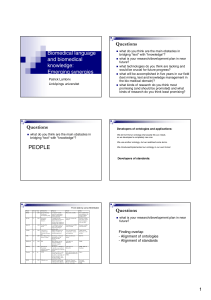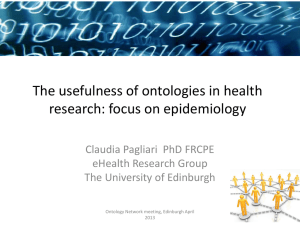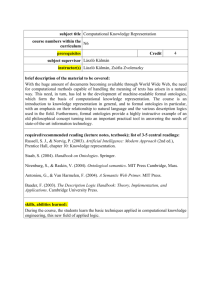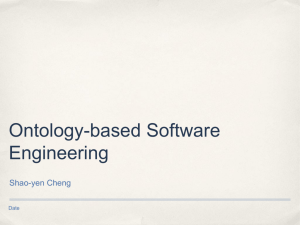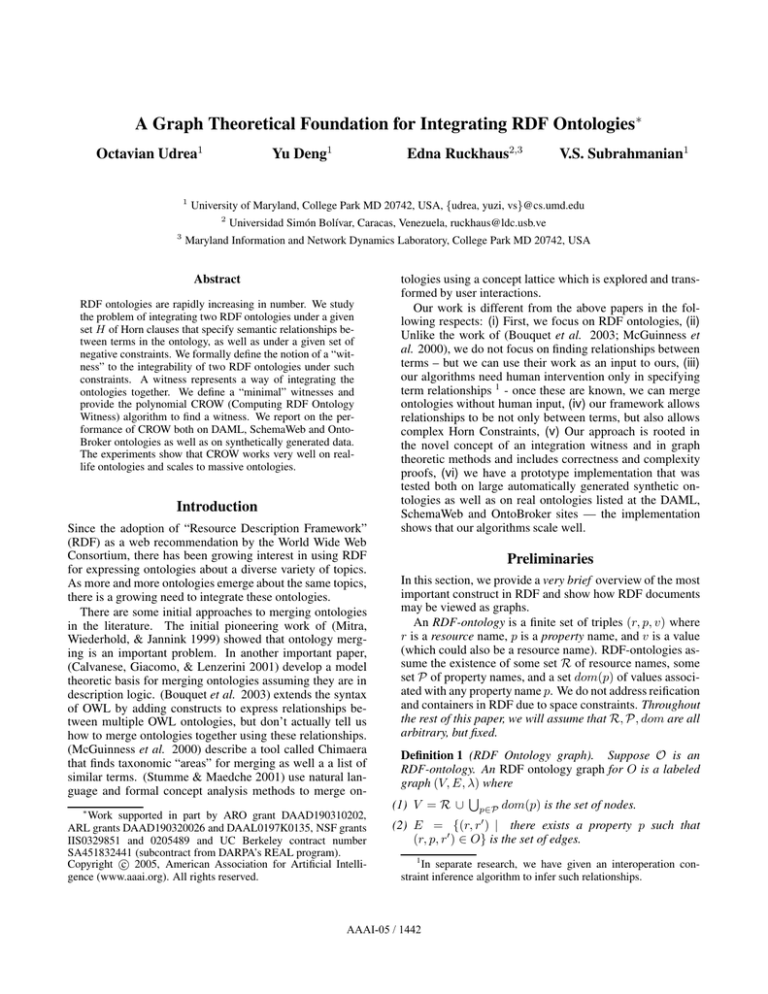
A Graph Theoretical Foundation for Integrating RDF Ontologies∗
Octavian Udrea1
1
Yu Deng1
V.S. Subrahmanian1
University of Maryland, College Park MD 20742, USA, {udrea, yuzi, vs}@cs.umd.edu
2
3
Edna Ruckhaus2,3
Universidad Simón Bolı́var, Caracas, Venezuela, ruckhaus@ldc.usb.ve
Maryland Information and Network Dynamics Laboratory, College Park MD 20742, USA
Abstract
RDF ontologies are rapidly increasing in number. We study
the problem of integrating two RDF ontologies under a given
set H of Horn clauses that specify semantic relationships between terms in the ontology, as well as under a given set of
negative constraints. We formally define the notion of a “witness” to the integrability of two RDF ontologies under such
constraints. A witness represents a way of integrating the
ontologies together. We define a “minimal” witnesses and
provide the polynomial CROW (Computing RDF Ontology
Witness) algorithm to find a witness. We report on the performance of CROW both on DAML, SchemaWeb and OntoBroker ontologies as well as on synthetically generated data.
The experiments show that CROW works very well on reallife ontologies and scales to massive ontologies.
Introduction
Since the adoption of “Resource Description Framework”
(RDF) as a web recommendation by the World Wide Web
Consortium, there has been growing interest in using RDF
for expressing ontologies about a diverse variety of topics.
As more and more ontologies emerge about the same topics,
there is a growing need to integrate these ontologies.
There are some initial approaches to merging ontologies
in the literature. The initial pioneering work of (Mitra,
Wiederhold, & Jannink 1999) showed that ontology merging is an important problem. In another important paper,
(Calvanese, Giacomo, & Lenzerini 2001) develop a model
theoretic basis for merging ontologies assuming they are in
description logic. (Bouquet et al. 2003) extends the syntax
of OWL by adding constructs to express relationships between multiple OWL ontologies, but don’t actually tell us
how to merge ontologies together using these relationships.
(McGuinness et al. 2000) describe a tool called Chimaera
that finds taxonomic “areas” for merging as well a a list of
similar terms. (Stumme & Maedche 2001) use natural language and formal concept analysis methods to merge on∗
Work supported in part by ARO grant DAAD190310202,
ARL grants DAAD190320026 and DAAL0197K0135, NSF grants
IIS0329851 and 0205489 and UC Berkeley contract number
SA451832441 (subcontract from DARPA’s REAL program).
c 2005, American Association for Artificial IntelliCopyright gence (www.aaai.org). All rights reserved.
tologies using a concept lattice which is explored and transformed by user interactions.
Our work is different from the above papers in the following respects: (i) First, we focus on RDF ontologies, (ii)
Unlike the work of (Bouquet et al. 2003; McGuinness et
al. 2000), we do not focus on finding relationships between
terms – but we can use their work as an input to ours, (iii)
our algorithms need human intervention only in specifying
term relationships 1 - once these are known, we can merge
ontologies without human input, (iv) our framework allows
relationships to be not only between terms, but also allows
complex Horn Constraints, (v) Our approach is rooted in
the novel concept of an integration witness and in graph
theoretic methods and includes correctness and complexity
proofs, (vi) we have a prototype implementation that was
tested both on large automatically generated synthetic ontologies as well as on real ontologies listed at the DAML,
SchemaWeb and OntoBroker sites — the implementation
shows that our algorithms scale well.
Preliminaries
In this section, we provide a very brief overview of the most
important construct in RDF and show how RDF documents
may be viewed as graphs.
An RDF-ontology is a finite set of triples (r, p, v) where
r is a resource name, p is a property name, and v is a value
(which could also be a resource name). RDF-ontologies assume the existence of some set R of resource names, some
set P of property names, and a set dom(p) of values associated with any property name p. We do not address reification
and containers in RDF due to space constraints. Throughout
the rest of this paper, we will assume that R, P, dom are all
arbitrary, but fixed.
Definition 1 (RDF Ontology graph). Suppose O is an
RDF-ontology. An RDF ontology graph for O is a labeled
graph (V, E, λ) where
S
(1) V = R ∪ p∈P dom(p) is the set of nodes.
(2) E = {(r, r0 ) | there exists a property p such that
(r, p, r0 ) ∈ O} is the set of edges.
1
In separate research, we have given an interoperation constraint inference algorithm to infer such relationships.
AAAI-05 / 1442
Figure 1: RDF (respectively OWL) for the two example ontologies
(3) λ(r, r0 ) = {p | (r, p, r 0 ) ∈ O} is the edge labeling function.
Graphs G1 and G2 are equivalent iff G1 v G2 and G2 v
G1 .
It is easy to see that there is a one-one correspondence
between RDF-ontologies and RDF-ontology graphs. Given
one of them, we can uniquely determine the other. As a consequence, we will often abuse notation and interchangeably
talk about both RDF-ontologies and RDF-ontology graphs.
Figure 1 shows parts of RDF ontologies 64 and 322 from the
DAML web site (www.daml.org) — their graphs are shown
in Figure 2. Note that both ontologies have had terms renamed (through the attachment of strings “:1” and “:2” respectively). Thus, STUDENT:2 refers to the student concept
in ontology 2.
Given two nodes r, r 0 in an RDF-ontology graph, and a
property name p, we say that there exists a p-path from r
to r0 if there is a path from node r to node r’ such that
every edge along the path contains p in its label. For example, in the second graph of figure 2, there is an S-path
from R ESEARCHER - IN -ACADEMIA to E MPLOYEE. Here S
stands for “subClassOf”. However, there is no A-path from
S TUDENT:2 to O RGANIZATION -U NIT:2 where A stands for
“Affiliate-Of”.
Our techniques differentiate between transitive and nontransitive properties. For instance, SUB C LASS O F is a transitive relationship, while AFFILIATE O F as depicted in Figure
2 is not. A cycle involving a transitive relationship could indicate a semantic problem (e.g. a B OSS O F b, b B OSS O F c,
c B OSS O F a seems to indicate a problem). However, a cycle
involving a non-transitive properties may not be a problem
(e.g. a F RIEND O F b, b F RIEND O F c, c F RIEND O F a is not
unusual).
Note that for any RDF ontology O, we can uniquely determine its RDF-ontology graph — however, there may be
many other graphs that are equivalent to it.
Definition 2 (Graph embedding) Let G1 = (V1 , E1 , λ1 )
and G2 = (V2 , E2 , λ2 ) be two RDF-ontology graphs. G1
can be embedded into G2 (denoted by G1 v G2 ) iff there
exists a mapping ω : V1 → V2 such that:
(1) For p transitive, if there is a p-path from r to r 0 in G1 ,
then there is a p-path from ω(r) to ω(r 0 ) in G2 .
(2) For q non-transitive, if there is an edge labeled with q
from r to r0 in G1 , then there is an edge labeled with q
from ω(r) to ω(r 0 ) in G2 .
Horn constraints
When integrating two RDF ontologies, there may be various kinds of constraints linking the terms in the two ontologies. For instance, we may say that the terms P ERSON :1 and
P ERSON :2 are equivalent. Likewise, we may say that if x is
a R ESEARCHER - IN -ACADEMIA :2 and also a S TUDENT:2,
then x is also a G RADUATE -S TUDENT:1. In general, for any
property p, we may have a Horn clause saying that as far as
property p is concerned, if an individual is in all classes in a
given set, then he is also in another given class.
Definition 3 (Horn constraint) If r1 , . . . , rn , r are all resource names, then
r1 ∧ · · · ∧ r n → r
2
is a Horn constraint.
Note that Horn constraints only specify class subclass relationships, and nothing else.
Definition 4 (Negative constraints) Suppose a, b are
nodes and q is a property. Then:
(1) a 6= b is a negative constraint.
(2) a 6→q b is a negative constraint (which states that there is
no q-path from a to b in the graph in question).
Two examples of negative constraints associated with Figure 2 are:
• FACULTY:16→S S TUDENT:2 which states that Faculty is
not a subclass of Student.
• S TUDENT:26→S FACULTY:1 which states that S TUDENT
is not a subclass of FACULTY.
Satisfaction of a Horn clause or a negative constraint by an
ontology is straightforward to define.
2
Strictly speaking, we should say “definite clause”(Lloyd 1987)
constraint here rather than Horn constraint, but we will abuse notation and call these Horn clauses.
AAAI-05 / 1443
Figure 2: Two simple ontologies
The RDF Ontology Integration Problem
In this section, we will declaratively define the problem of
integration of two RDF ontologies under a given set of Horn
and negative constraints. To do this, we first define the notion of a “Horn Ontology Graph” (HOG for short) which
merges Horn constraints with an ontology.
Definition 5 (Horn Ontology Graph (HOG)) Suppose O
is an ontology and H is a finite set of Horn constraints over
R, P, dom. The Horn Ontology Graph, HOG(O, H) is defined as the labeled graph G = (V, E, λ) where:
(1) If a is either a resource name or a domain value in O,
then {a} is a node in V .
(2) If r1 ∧ . . . ∧ rn → r is in H, then there is a node in
V called “ {r1 , . . . , rn }” — sometimes, we may abuse
notation and write this node’s label as “r1 ∧ . . . ∧ rn ”
(3) Whenever there are two nodes A, B in V such that A ⊆
B, then there is an edge labeled S from B to A.
(4) If r1 ∧ . . . ∧ rn → r is in H, then there is an edge labeled
S in E from “ {r1 , . . . , rn }” to {r}.
(5) If there is an edge in O 0 s graph from a to b labeled p, then
there is an edge in E from {a} to {b} labeled p.
Intuitively, the nodes in the Horn ontology graph are obtained by taking nodes in O’s graph and making singleton
sets out of them. In addition, we take the body of each Horn
constraint and make it a node labeled by the entire body of
the Horn constraint.
As far as edges are concerned, condition (5) says that all
edges in O are present in the HOG (the only difference is
that an edge in the original RDF graph from a to b ends up
being an edge from {a} to {b}). In addition, for every Horn
clause in H, we add an edge from the set associated with its
body to the singleton set associated with its head.
Strictly speaking, we may be able to eliminate some edges
from HOG(O, H). For instance, if we have one Horn
clause with the body {a, b, c}, another with the body {a, b}
and yet another with the body {a}, then condition (3) above
states that there should be an edge from both {a, b} and
{a, b, c} to {a} as well as an edge from {a, b, c} to {a, b}.
We henceforth assume all such redundant edges are eliminated. It is easy to see that the Horn Ontology Graph thus
Figure 3: HOG example (partial)
defined is unique and
S can be constructed from H and O in
time O(|H| · |R ∪ p∈P dom(p)|).
Figure 3 shows the HOG associated with the union of the
two RDF graphs shown in Figure 2 under a given set of Horn
constraints.
Definition 6 (Integrability witness) Suppose O1 , O2 are
two ontologies, H is a finite set of Horn clauses and N C is a
finite set of negative clauses. An ontology graph G = (V, E)
is said to be a witness to the integrability of O1 , O2 w.r.t. H
and N C iff:
(1) G contains no p-cycles3 for any transitive property p,
(2) HOG(O1 ∪ O2 , H) v G.
We define the distance between a witness G to the integrability of ontologies O1 , O2 subject to Horn constraints
H and negative constraints N C as: d(G, hO1 , O2 , Hi) =
|G1 | + |G2 | + |H| − |G| where Gi is the graph associated
with ontology Oi .
Definition 7 (Minimal integrability witness) Suppose
O1 , O2 are two ontologies with associated graphs G1 , G2 ,
H is a finite set of Horn constraints and N C is a finite set
of negative constraints. A witness G to the integrability
of G1 , G2 w.r.t. H and N C is minimal if and only if
there is no strict subgraph4 G0 of G which is a witness
to the integrability of O1 , O2 w.r.t. H and N C such that
0 ≤ d(G0 , hO1 , O2 , Hi) ≤ d(G, hO1 , O2 , Hi).
Note that the minimal integrability witness is minimal in two respects: first, its graph structure is minimal (i.e. it does not contain unnecessary nodes and
edges) and in addition, the distance according to the dmetric is minimized. Figure 4 shows a minimal witness to the integrability of the ontologies in Figure 2
using the Horn Constraints shown in Figure 3 and
the negative constraints FACULTY:16→S S TUDENT:2 and
S TUDENT:26→S FACULTY:1 discussed earlier.
3
4
A p-cycle is a p-path of length 1 or more from a node to itself.
We use the standard definition of subgraph.
AAAI-05 / 1444
Figure 5: Intermediate result CROW phase (2)
Figure 4: Minimal integrability witness
RDF Ontology Integration Problem. The RDF ontology
integration problem is specified as follows:
I NPUT: RDF ontology graphs O1 , O2 , a finite set H or Horn
constraints, and a finite set N C of negative constraints.
O UTPUT: Return a minimal witness to the integrability of
O1 , O2 w.r.t. H and N C if a witness exists — otherwise
return NULL.
The CROW Algorithm to integrate Ontologies
In this section, we present the CROW (Computing RDF Ontology Witness) algorithm to solve the RDF ontology integration problem. The CROW algorithm has four distinct
phases:
(1) In the pre-processing phase, we rename the ontologies being merged so that terms in different ontologies are different (this is done by merely appending the ontology id to
the end of each term).
(2) In the graph construction phase, CROW constructs
HOG(O, H).
(3) In the graph transformation phase, the above graph is
simplified using various kinds of strongly connected computations which we will describe shortly. Redundant
edges are also eliminated during this phase.
(4) In the negative constraint check phase, we check whether
the graph produced above satisfies the negative constraints. If not, we return “NULL” otherwise we return
the graph produced in (3) above.
The heart of the algorithm is in step (3) above — we have
already explained steps (1) and (2) earlier on in the paper.
We apply two graph transformations.
Definition 8 Suppose G is an RDF ontology graph, and p
is any relation in P that is known to be transitive.
• A p-strongly connected component (or p-SCC for short)
is any set S of nodes in G such that for all a, b ∈ S, there
is a p-path from a to b.
• The operator ςp (G) returns that graph G0 = (V 0 , E 0 )
where:
– V 0 is the set of all p-SCCs in G and
– E 0 contains an edge from an SCC S1 to an SCC S2
labeled p iff there is an edge in G from some node in S1
to some node from S2 labeled p.
ςp (G) reduces all p-SCCs in G to a single node and
then draws edges between two such reduced nodes if
there was some node in one of the SCCs that was connected in the original graph G to some node in the other
SCC. This is an intuitive method for reducing cycles for
transitive relationships (e.g.: if W ORKER :1 SUB C LAS S O F W ORKING P ERSON :2 and W ORKING P ERSON :2 SUB C LASS O F W ORKER :1, it would be safe to conclude that
W ORKER :1=W ORKING P ERSON :2). Note that ςp (G) is a
lossy transformation as edges not labeled with p between
nodes in the p-SCCs are lost. The second transformation υp (O) - is used to eliminate redundant edges and thus obtain
a minimal integration witness.
Definition 9 An edge from a to b labeled p is said to be
redundant w.r.t. graph G iff there is a p-path from a to b in
the graph obtained by deleting this edge from G.
The operator υp (G) returns a graph G0 by eliminating as
many redundant edges on transitive properties from G as
possible.
There may be many ways in which redundant edges are removed from a graph G — all we require here is that υp (G)
return any subgraph of G with no redundant edges.5
Theorem 1 For any graph G:
(1) G v ςp (G)
(2) G v υp (G).
The proof is based on the analysis of a single p-SCC or
redundant edge elimination operation; each such operation
preserves the v relation.
We are now ready to present the CROW algorithm (after
the pre-processing step). Although the CROW algorithm is
5
As such there can be many different implementations of
υp (G). One such algorithm works as follows. First, it computes
an adjacency matrix A for G. It then computes a path matrix B
such that B[i, j] = 1 iff there is a path of length two or more from
node i to j. This can be computed by a straightforward adaptation of Dijkstra’s algorithm. Now remove all edges (i, j) for which
A[i, j] = 1 and B[i, j] = 1.
AAAI-05 / 1445
designed for integrating two ontologies, a simple extension
can be used to integrate sets of ontologies 6 .
Algorithm: CROW(O1 , O2 , H, N C)
Inputs:
Ontologies O1 , O2 , set of Horn constraints H and set of negative constraints N C.
Let
G1 = (V1 , E1 ), G2 = (V2 , E2 ) be the associated graphs.
Output: G = (C, E, λ), minimal witness to the integrability
of O1 , O2 w.r.t. H and N C or N U LL if no minimal witness
exists.
1. C ← V1 ∪ V2 ;
2. E ← E1 ∪ E2 ;
3. for r1 ∧ . . . ∧ rk → r ∈ H in ascending order of k do
4. C ← C ∪ {r1 , . . . , rk };
5. E ← E ∪ {({r1 , . . . , rk }, r)};
6. for all n ∈ C, n ⊂ {r1 , . . . , rk } do
7.
E ← E ∪ {({r1 , . . . , rk }, n)};
8. end
9. end
10. for all properties p
11. if p transitivea then
12.
while ∃ S, p-SCC in G do
13.
for a * b ∈ V do
(* by * we denote any type of negative constraint *)
14.
if a ∈ S and b ∈ S return NULL;
15.
end
16.
G = ςpS (G);b
17.
end
18.
G = υp (G);
19. end
20. for cons ∈ V labeled with p do
21.
if G does not satisfy cons then return NULL;
22. end
23. end
24. return O;
a
b
The following result shows that CROW is correct.
Theorem 2 (Correctness of CROW) CROW is correct, i.e.
(i) If CROW(O1 , O2 , H, N C) does not return NULL, then it
returns a minimal witness to the integrability of G1 , G2 w.r.t.
H and
(ii) If CROW(G1 , G2 , H, N C) returns NULL, then there is
no witness to the integrability of G1 , G2 w.r.t. H.
Proof sketch. (i) Since all sets are finite and operations
on lines 10-19 reduce the number of edges and/or nodes
in the ontology, the algorithm will terminate. By the construction of the HOG in lines 1-9 we can easily see that
G1 v HOG(G1 ∪ G2 , H) and G2 v HOG(G1 ∪ G2 , H).
Furthermore, by Theorem 1 the graph transformations applied to G = HOG(G1 ∪ G2 , H) preserve order. Also, G
will satisfy N C according to lines 14, 20-22. Hence, the returned ontology G is an integration witness for G1 , G2 w.r.t
H and N C. Let us assume that G is not a minimal integrability witness and ∃ G0 an integrability witness which is a
strict subgraph of G. If G0 has fewer nodes than G, it would
violate the distance condition in Definition 7. Otherwise, if
G0 has fewer edges than G, since all redundant edges for
transitive properties have been eliminated in G, that would
mean G0 violates condition (2) of Definition 6. Our hypothesis was false, hence G is a minimal integrability witness. (ii)
Let us assume that there is a minimal integrability witness
G that the CROW algorithm does not find. This means that
CROW has returned NULL on either line 14 or 21. However, these directly correspond to checks against the negative constraints in N C. Therefore, G does not satisfy N C
and cannot be a minimal integrability witness.
The following theorem states that CROW runs quite fast.
Theorem 3 (CROW complexity) Let ni , ei be the number
of nodes and respectively edges in Gi , i ∈ {1, 2}. Let nh
be the number of constraints in H and t the number of transitive properties. We denote by n, e the number of nodes
and respectively edges in G. Then according to the CROW
algorithm:
Specified a priori.
Collapses only S into one node.
In lines 1-9, CROW first constructs the Horn Ontology
Graph. The result of this first phase is depicted in Figure 5. The reader may notice that this graph contains both
strongly connected components for the SUB C LASS O F hierarchy (S TUDENT:1 ↔S S TUDENT:2) as well as redundant edges (P H D-S TUDENT:2 SUB C LASS O F S TUDENT:2).
The reduction of strongly connected components and redundant edges is suitable only for transitive properties, as discussed in the Preliminaries Section. After these transformations (lines 16-18) the algorithm verifies the satisfiability of the negative constraints against the integrated ontology (lines 20-22). Note that some negative constraints can
checked directly while detecting SCC, which optimizes the
response time for cases when there is no minimal integrability witness. Figure 4 shows the result of integrating the
ontologies in Figure 2 using the Horn constraints in Figure
3 and using the negative constraints: N C = {Faculty:16→S
Student:2,Student:26→S Faculty:1}.
6
For instance, by using CROW repeatedly or by merging all the
ontology graphs at the same time.
(1) n ≤ n1 + n2 + nh and e ≤ e1 + e2 + 2 · nh .
(2) CROW is O(t · n · e · (n + e)).
The proof follows directly from the analysis of the CROW
algorithm.
Implementation and Experiments
Our prototype is implemented in Java and currently consists
of 3041 lines of code. It consists of the following components:
1. The RDF Graph Generator. We use Jena 2.2, a Semantic Web toolkit from Hewlett-Packard Labs, to digest an
ontology data file. Then the RDF Graph Generator constructs an ontology graph by reading a set of RDF triples
stored in Jena.
2. The HOG Generator generates a HOG for a set of Horn
clauses.
3. The Synthetic Data Generator randomly generates ontology graphs, Horn constraints and negative constraints.
AAAI-05 / 1446
Ontology 1
DAML - 64
DAML - 4
DAML - 62
SchemaWeb - 236
DAML - 276
Ontology 2
DAML - 189
DAML - 62
OntoBroker - ka2.daml
SchemaWeb - 197
SchemaWeb - 162
# constraints
17
25
20
8
32
size1
485
1171
1019
959
1706
size2
820
2142
1864
1829
2938
size3
826
2147
1868
1841
2946
size4 (KB)
17.944
52.564
51.972
51.152
81.667
# transitive
3
1
1
1
4
Time (ms)
40.2
32
22.2
24
58.4
Table 1: Experimental results
Scalability on synthetic data. We randomly generated ten
pairs of ontology graphs (each with only one transitive property). The total number of terms in each pair of ontologies
varies from 8000 to 35000 with a step of 3000. For each
pair, we generate ten sets of constraints (including Horn and
negative constraints) whose sizes vary from 10 to 100 with
a step of 10.
Figure 6 shows the scalability of CROW algorithm on the
ten pairs of ontologies. As the total number of terms increased, we had a slightly faster than linear increase in the
time taken to do the integration. The increase in running
time is mainly due to the increase in number of terms (and
the size of the HOG) more than to the increase in number of
constraints, as shown in Figure 6.
Conclusions
Figure 6: CROW running time
4. The Ontology Integrator integrates ontologies by taking
a set of Horn constraints and a set of negative constraints
into account.
Scalability experiments. We report here the performance
of CROW algorithm on both real-life and synthetically generated ontologies. The experiments were run on a PC with
1.4GHz CPU, 524MB memory and Windows 2000 Professional platform. The times taken in the experiments include
the time to construct an HOG and the time to integrate ontologies.
Scalability on real-life ontologies. We have applied our
CROW algorithm to five pairs of similar ontologies7 selected from DAML, SchemaWeb and OntoBroker ontology
libraries. We list the detailed experimental results in Table 1. We have used various metrics for the size of ontologies (using the notations from Theorem 3): (i) size1 =
n1 + n2 + nh ,(ii) size2 = n1 + n2 + e1 + e2 + nh , (iii)
size3 is the number of nodes and edges in the HOG and
(iv) size4 is the total file size of the source ontologies. The
running time of CROW algorithm is related to not only the
number of terms and edges, but also to the number of transitive properties. We can see the effect of this factor in Table
1 by comparing the first and third pair of ontologies.
In this paper, we have developed a formal model to integrate
RDF ontologies in the presence of both Horn constraints and
negative constraints. We have explained the concept of a
witness to the integrability of two ontologies and we have
developed the CROW algorithm to integrate two ontologies.
We have tested CROW and found that it is very fast, both
on ontologies at the DAML, SchemaWeba and OntoBroker
sites, but also on synthetically generated ontologies.
References
Bouquet, P.; Giunchiglia, F.; van Harmelen, F.; Serafini,
L.; and Stuckenschmidt, H. 2003. C-owl: Contextualizing ontologies. In International Semantic Web Conference,
164–179.
Calvanese, D.; Giacomo, G. D.; and Lenzerini, M. 2001.
A framework for ontology integration. In SWWS, 303–316.
Lloyd, J. 1987. Foundations of Logic Programming.
Springer Verlag.
McGuinness, D. L.; Fikes, R.; Rice, J.; and Wilder, S.
2000. An environment for merging and testing large ontologies. In Proc. 7th Int. Conf. on Principles of Knowledge
Representation and Reasoning.
Mitra, P.; Wiederhold, G.; and Jannink, J. 1999. Semiautomatic integration of knowledge sources. In Proc. of
the 2nd Int. Conf. On Information FUSION’99.
Stumme, G., and Maedche, A. 2001. Fca-merge: Bottomup merging of ontologies. In IJCAI, 225–234.
7
Two on academic departments, one each on publications,
travel and music.
AAAI-05 / 1447



